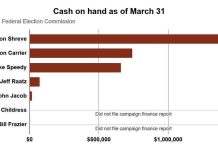The workforce at Major Tool & Machine Inc. is the kind any business owner would want to keep healthy, but that might need an extra nudge.
The 330 machinists, fabricators, welders and other skilled workers are overwhelmingly male and in their 40s and 50s. They are on their feet for hours a day and do plenty of bending and lifting. Some smoke and carry a few extra pounds. Not long ago, many didn’t even have a primary care physician.
So about a decade ago, the company set up a wellness program to encourage workers to drop bad habits and replace them with healthier activities. Workers received $100 gift cards for completing a physical and filling out a health risk assessment.
Over the years, the program grew and the company opened an on-site health clinic with a full-time doctor, nurse practitioner and medical assistant. Some of the workers who didn’t have their own doctors began to get regular screenings and wellness advice.
And the company handed out big incentives: workers who scored well on biometric screenings for body mass, tobacco use, cholesterol, glucose and blood pressure could earn discounts worth hundreds of dollars a year on their health insurance premiums.
Today, more than 90 percent of Major’s workforce participates, well above the national average of 40 percent at companies offering wellness programs.
So company officials were paying close attention last month when the U.S. Equal Employment Opportunity Commission issued final rules on how corporate wellness programs must operate to stay within antidiscrimination laws, such as the Americans with Disabilities Act and the Genetic Information Nondiscrimination Act.
Under those laws, employers are prohibited from using information about workers’ health conditions unless the information is collected under a voluntary program.
What it boils down to is this: if you dangle big incentives or punishments, potentially worth thousands of dollars to workers, is your program really voluntary?
The EEOC said that such programs could be considered voluntary as long as the incentives or discounts don’t exceed more than 30 percent of the cost of the employees’ health coverage.
What the EEOC was seeking to do was make sure wellness programs promoted health and were not a cover for collecting sensitive health information.
“There were some employers that were running wellness programs that said, ‘If you don’t take this health risk assessment, you can’t be in our insurance program,’” said Chris Sears, a labor lawyer and partner at Ice Miller and a member of its Employee Benefits Group.
He added:”The EEOC has said, ‘Well, then those programs are not voluntary; they’re coercive.’ … Because this is how most of us get our health coverage, through our employers.”
Major Tool said it’s not worried that its wellness incentives cross the line.
“We’re right at the 30 percent threshold that we’re allowed under the Affordable Care Act,” said Kim Davison, a human resources generalist at Major, on East 19th Street in the Martindale-Brightwood neighborhood.
Pursuing employers
In recent years, the EEOC has gone after companies it claims have violated federal law with over-generous or coercive wellness programs.It sued Honeywell International of New Jersey, claiming the company acted inappropriately in fining workers up to $4,000 for not agreeing to biometric testing.
It went after Orion Energy Systems of Wisconsin, saying the company stopped contributing to an employee’s insurance coverage when she refused to submit to a screening and later fired her.
And it sued Flambeau Inc., a Wisconsin maker of plastic products, alleging the company threatened to discipline an employee and cancel his health insurance if he didn’t submit to medical testing and a health risk assessment.
Those cases are pending. Meanwhile, other employers are taking a cue and giving another look at their programs to make sure they don’t skirt the law.
Major Tool said its program is clearly voluntary and well within the federal guidelines.
“We were always within the limits of ACA’s limited percentage,” Davison said. “We have disclaimers over all of the materials that say if you can’t meet a standard, we will provide an alternative standard.”
Around Indiana, employers are glad the EEOC is offering clear rules on what constitutes a voluntary wellness program that won’t run the risk of a federal lawsuit, said Chuck Gillespie, executive director of the Wellness Council of Indiana, part of the Indiana Chamber of Commerce.
“The new rules should prove to be a benefit and allow workplaces to feel more confident providing some of these tools and programs and know they won’t be sued,” Gillespie said.
Dangling incentives
At Cummins Inc., employees can get discounts of up to $600 a year on their health insurance premiums if they (and their dependents) follow the guidelines on various activities, such as wearing pedometers and demonstrating that they are staying active.More than 80 percent of the Columbus-based technology company’s 17,000 employees take part in the wellness program, said Dr. Dexter Shurney, chief medical director of Cummins’ wellness programs.
The company said it doesn’t pressure any employees to take part, and it sends all the health information to an outside contractor to reassure workers about privacy issues.
“We don’t see the information,” he said. “We use a third party. We make sure privacy is there.”
Some consultants say most Indiana companies have little to worry about. Their wellness programs are small, and the incentives are well under the limits.
“A lot of the groups I work with are not even close to 30 percent,” said Susan Rider, a benefits consultant at Gregory & Appel, a large Indianapolis insurance agency.
But workplace wellness is big business: about $6 billion a year, as employers try to reduce the high costs of health care by promoting prevention, according to Kaiser Health News.
About half of all organizations with 50 or more employees have a wellness program, according to an analysis by the Rand Corp.
Key provisions
For employers who are pushing the programs hard, perhaps to drive down their insurance costs, the key is to be careful and study the rules, some legal experts say.The final rule goes into effect Jan. 1. Among some other provisions:
Employees must not be required to participate in a wellness program.
Employees cannot be denied health care coverage or prohibited from choosing any particular health plan just because they do not participate in a wellness program.
Employers can’t retaliate against, interfere with, coerce, intimidate or threaten any employee who chooses not to participate in a wellness program or fails to achieve certain health outcomes.
In the meantime, employers are increasingly using a variety of carrots to get their workers to stop smoking, eat nutritious foods and stay on medications for chronic diseases. They are turning to an assortment of incentives, including gift cards, gym memberships and even frequent-flier miles, in addition to discounts on health premiums.
But the new rules spell out what all those incentives can add up to: namely, 30 percent of the total cost for self-only coverage of the plan in which the employee is enrolled.
For example, if the total employee cost for self-only coverage for the plan is $6,000 a year, the employer can reward the employee up to $1,800 for participating in the wellness program and achieving certain outcomes.
The rules are available on the EEOC website.
In recent weeks, dozens of law and benefits experts have published papers explaining the rules’ impact and are offering advice.
For example: the rules require that employers provide a notice to workers that explains what medical information their employer will obtain, how it will use that information and what restrictions exist on the disclosure of that information, according to a summary by Pepper Hamilton LLP, a large, Philadelphia-based law firm.
“The new regulations provide some comfort to employers,” the law firm said in a newsletter, “who may now rely on defined parameters for designing wellness programs.”




